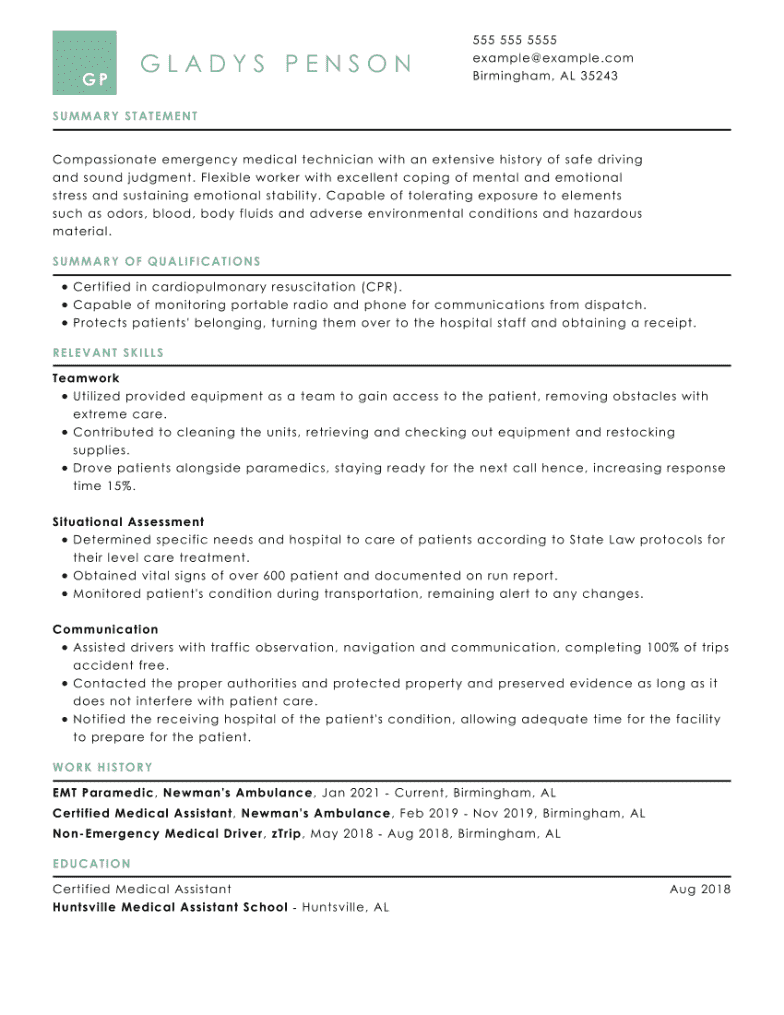Dynamic EMT CV examples to use
Emergency medical technician (EMT) CVs require specific certifications to be considered for the job. Check out our CV examples to craft your perfect CV.
Emergency medical technician (EMT) CVs require specific certifications to be considered for the job. Check out our CV examples to craft your perfect CV.





OUR USERS HAVE BEEN HIRED BY

An emergency medical technician (EMT) is one of the first people to respond to emergency situations and administer First Aid and life support to patients. As such, the EMT job requires a person to work under highly stressful conditions at odd hours. Let’s take a closer look into how you can craft the perfect professional CV for your new job as an EMT!
The EMT CV should heavily focus on education, qualifications, safety certifications, licences and patient care experience. As an experienced EMT with years of experience, you should highlight experiences that are relevant to the job to which you are applying.
If you are recently out of university and your apprenticeship, you should focus more on your education and apprenticeship. You can also supplement your lack of experience with a career objective – a statement on your CV where you highlight your goals and what you hope to accomplish in the role.
Formatting your CV is crucial to catching the recruiter’s eyes. You should emphasise relevant EMT skills, certifications and licences, and any previous work experience you have had in the healthcare or first responder fields. The EMT CV should follow this format:
The CV header is where you will include your contact information, such as:
A professional summary is a paragraph at the top of your CV and provides an overview of your work history and years of experience, skills, and qualifications. Note that while similar, a professional summary is not a career objective, which includes your goals and what you’re seeking to accomplish with your CV.
This can be particularly important if you are just starting out in the work world, are making a career change, or are looking at a specific sector of work. Writing a good professional summary can benefit any CV.
The professional summary should highlight your patient care and life support experience, medical equipment expertise and any other relevant skills the job description might call for. Think of this section as your “elevator pitch” for your qualifications, featuring information that can be highlighted in your cover letter or job interview.
The skills section should be kept to a list of bullet points that relate to the job description. A few relevant EMT skills to include on your CV will be:
List jobs, and achievements associated with those jobs, that can apply to EMT work. Some EMT training courses offer internship opportunities. If you are an aspiring EMT, these internships can be invaluable to your overall work experience and are a great addition to your CV. Volunteer experience as a lifeguard or EMT ride-along is also good to add to a CV if you don’t have much, or any, work experience. These roles can build up your professional experience for higher-level EMT positions in the future.
To become an EMT, you’ll need a paramedic science degree, which is approved by the Health and Care Professions Council. Earning this degree usually takes 3 years when enrolled full-time at university.
You will also have to complete a paramedic degree apprenticeship. An electrician apprenticeship doesn’t have any set entry requirements, but 4 or 5 GCSEs at grades 9 to 4 and A levels (or the equivalent) will increase your chances.
The professional summary should highlight your patient care and life support experience, medical equipment expertise and any other relevant skills the job description might call for. Think of this section as your “elevator pitch” for your qualifications, featuring information that can be highlighted in your cover letter or job interview.
Barry Smith
101 Main Street
Nottingham, England
5555555555
barrysmith@example.com
Professional Summary
Certified Emergency Medical Technician skilled at providing pre-hospital evaluations of patient conditions. Able to start critical treatments in-field and transport sick and injured patients to hospitals.
Skills
Work Experience
Emergency Medical Technician Trainee, Example Medical Centre, May 2020 – Current, Nottingham, England
Education
Nottingham Trent University, Ambulance Technician Practise (ATP) – Nottingham, England, January 2021
Certifications
Qualified EMT – March 2022
A paramedic is basically the highest-ranking EMT. EMTs offer basic life support and emergency care, often assisting the higher-level EMTs and paramedics. Therefore, a paramedic CV will look much different compared to the average EMT CV. The paramedic CV will include more complicated emergency care procedures and advanced life support such as:
An EMT can be promoted to paramedic after building up years of experience, extensive medical care training, and proven success in their field.
The cover letter tells recruiters more about your applicable skills and work experience. It gives you the perfect opportunity to explain why you are the best fit for a job. Check out the CVHelp cover letter builder to get started!
If you’re still having trouble writing any aspect of your professional CV, then the CVHelp CV builder tool can help! With dozens of CV templates, CV examples, CV samples, and more, CV writing has never been so easy. You can craft the perfect CV in just a few minutes.
We personalize your experience.
We use cookies in our website to ensure we give you the best experience, get to know our users and deliver better marketing. For this purpose, we may share the information collected with third parties. By clicking “Allow cookies” you give us your consent to use all cookies. If you prefer to manage your cookies click on the “Manage cookies” link below.